Natural Supplements That May Reduce Hot Flashes
Introduction
Few menopausal symptoms are as instantly recognizable—or as disruptive—as hot flashes. One moment you’re fine, and the next, a sudden wave of heat surges through your body, your face flushes, and sweat beads at your temples. For some women, it lasts seconds; for others, minutes. And when it happens at night, it can interrupt precious sleep and leave you drained the next day.
Hot flashes are among the most common symptoms of perimenopause and menopause, affecting up to 75% of women. While hormone replacement therapy (HRT) can be effective, not everyone wants or can take it. The good news? Nature provides several evidence-backed options that can help cool your internal thermostat and restore balance—without hormones. 🌿
In this guide, we’ll explore the most studied natural supplements that may help reduce hot flashes, how they work, and how to use them safely as part of your wellness routine.
Looking for supplements for This? Click here.
🌸 Understanding Hot Flashes
To understand how supplements can help, it’s important to know why hot flashes occur.
During menopause, the ovaries produce less estrogen and progesterone, the hormones that help regulate body temperature, mood, and circulation. When estrogen levels drop, the brain’s thermostat—known as the hypothalamus—becomes more sensitive to slight changes in body temperature.
Even a minor trigger, like warm air or emotional stress, can signal your body to release heat suddenly, dilating blood vessels and increasing blood flow to the skin. The result: warmth, redness, and sweating, often followed by chills.
Triggers can include caffeine, alcohol, spicy food, hot rooms, stress, or even strong emotions.
While lifestyle changes like wearing light clothing, staying hydrated, and practicing breathwork can help, supplements can address the root imbalances—especially hormonal fluctuations and inflammation—that drive these temperature swings.
🌿 Black Cohosh (Actaea racemosa)
Black cohosh is one of the most popular and well-studied herbal remedies for menopause. Traditionally used by Native American women, this root contains triterpene glycosides, compounds believed to affect serotonin and dopamine pathways in the brain—the same systems influenced by estrogen.
How it helps:
Black cohosh doesn’t act like estrogen directly; instead, it seems to modulate the hypothalamus, helping regulate temperature perception and reduce vasomotor symptoms like hot flashes and night sweats.
The science:
A meta-analysis published in Maturitas found that black cohosh significantly reduced the frequency and severity of hot flashes compared to placebo. Some women experienced improvements within 4–8 weeks of consistent use.
Dosage:
20–40 mg daily of standardized extract (such as Remifemin®).
Tip:
Pair black cohosh with magnesium or B-complex vitamins for extra support in nervous system regulation.
🌺 Red Clover (Trifolium pratense)

Red clover is rich in isoflavones, plant-based compounds that mimic weak estrogenic effects. These phytoestrogens bind to estrogen receptors and help balance fluctuations in estrogen levels, making it one of the gentler ways to support hormonal equilibrium.
How it helps:
Red clover may reduce hot flash frequency, improve sleep, and support bone and cardiovascular health—all areas affected by low estrogen.
The science:
In a 2016 study published in PLOS One, postmenopausal women who took 80 mg of red clover extract daily reported a 44% reduction in hot flash frequency after 12 weeks.
Dosage:
40–80 mg per day of standardized red clover isoflavones (containing 8% isoflavone content).
Tip:
Because red clover is mild, results are gradual. Combine it with soy isoflavones or evening primrose oil for enhanced effects. 🌸
🌼 Soy Isoflavones
Soy isoflavones are among the most well-documented phytoestrogens studied for menopause. These compounds, especially genistein and daidzein, mimic estrogen in the body, helping to stabilize hormonal changes that cause hot flashes.
How they help:
Soy isoflavones bind to estrogen receptor beta (ER-β), which influences thermoregulation and reduces vasomotor instability.
The science:
A review in Menopause (2012) found that women taking soy isoflavones experienced a 26% reduction in hot flash frequency compared to placebo. Benefits are most noticeable after several weeks of continuous use.
Dosage:
50–100 mg per day of soy isoflavones, ideally from fermented soy or standardized supplements.
Tip:
Fermented soy (like tempeh or miso) enhances absorption. Avoid highly processed soy powders with added sugars or fillers.
🌺 Flaxseed
Flaxseed contains lignans, another form of phytoestrogen that helps balance estrogen metabolism. It also provides omega-3 fatty acids and fiber, supporting cardiovascular and digestive health—two areas often impacted by menopause.
How it helps:
Flaxseed’s lignans may gently modulate estrogen activity, improving hormone metabolism and reducing inflammation that worsens hot flashes.
The science:
A clinical trial in Journal of the Society for Integrative Oncology found that women consuming 40 grams of ground flaxseed daily experienced a 50% decrease in hot flash frequency and intensity.
Dosage:
1–2 tablespoons of ground flaxseed daily (best absorbed when freshly ground).
Tip:
Add flaxseed to smoothies, oatmeal, or yogurt. Pair with vitamin E or omega-3 supplements for enhanced benefits. 🌿
🌸 Maca Root (Lepidium meyenii)
Maca, a Peruvian adaptogen, is known as a natural hormone balancer. It doesn’t contain phytoestrogens, but it nourishes the hypothalamic-pituitary-ovarian (HPO) axis, helping your body regulate its own hormone production.
How it helps:
Maca may reduce hot flashes, night sweats, and mood swings while improving energy and libido.
The science:
A 2008 study published in Menopause found that women who took 3.5 grams of maca per day for six weeks reported significant reductions in hot flashes and improved mood compared to placebo.
Dosage:
2–3 grams of maca powder daily, or 500–1000 mg in capsule form.
Tip:
Choose gelatinized maca (pre-heated to remove starch) for better absorption and gentler digestion. 🌺
Looking for supplements for This? Click here.
🌿 Evening Primrose Oil (Oenothera biennis)
Evening primrose oil is rich in gamma-linolenic acid (GLA), a fatty acid that helps regulate prostaglandins—hormone-like compounds involved in inflammation and body temperature control.
How it helps:
GLA supports hormonal balance, skin hydration, and mood while reducing hot flash intensity and breast tenderness.
The science:
A 2013 study in Archives of Gynecology and Obstetrics found that women who took 500 mg of evening primrose oil twice daily for six weeks experienced reduced severity and frequency of hot flashes.
Dosage:
500–1000 mg of evening primrose oil daily.
Tip:
Combine evening primrose with vitamin E or fish oil for synergistic anti-inflammatory effects. 💧
🌾 Sage (Salvia officinalis)
Sage has long been used in herbal medicine to calm excessive sweating and heat. It acts on the thermoregulatory center in the brain, helping stabilize body temperature.
How it helps:
Sage reduces perspiration, improves mood, and supports memory—making it a well-rounded herb for menopausal wellness.
The science:
A 2011 clinical trial found that fresh sage extract reduced hot flash frequency by 64% after eight weeks.
Dosage:
300–600 mg per day of standardized sage extract, or enjoy sage tea daily.
Tip:
Combine sage with lemon balm or peppermint tea for a refreshing, cooling effect. 🌿
🌼 Dong Quai (Angelica sinensis)
Often called the “female ginseng,” dong quai has been used in traditional Chinese medicine for centuries to balance hormones and nourish the blood.
How it helps:
Dong quai acts as a uterine tonic and mild phytoestrogen, supporting estrogen balance and circulation. It’s often used alongside other herbs like black cohosh or red clover.
The science:
While research results are mixed, some studies show dong quai can modestly reduce hot flashes and menstrual-like discomfort when combined with other herbal formulas.
Dosage:
500–1500 mg of root extract daily.
Tip:
Avoid if you’re taking blood thinners or have clotting disorders.
🌸 Ashwagandha (Withania somnifera)
An Ayurvedic adaptogen, ashwagandha helps the body adapt to stress—a common hot flash trigger. It balances cortisol, supports thyroid function, and improves sleep and mood.
How it helps:
Ashwagandha promotes nervous system balance, reducing anxiety-induced hot flashes and helping the body regulate temperature more effectively.
The science:
In a 2021 study, women taking 300 mg of KSM-66 ashwagandha twice daily experienced significant improvement in menopausal symptoms, including hot flashes, mood, and sleep quality.
Dosage:
300–600 mg per day of root extract.
Tip:
Take in the evening for relaxation or pair with magnesium glycinate for restorative sleep. 🌙
🌺 Omega-3 Fatty Acids
Omega-3s from fish oil or algae oil help reduce inflammation and stabilize mood, two key factors that can intensify hot flashes.
How they help:
They lower inflammatory prostaglandins, support vascular health, and improve serotonin function, which regulates both mood and temperature control.
The science:
A 2011 study in Menopause found that women taking 1000 mg of EPA daily reported fewer and less intense hot flashes over eight weeks.
Dosage:
1000–2000 mg combined EPA/DHA per day.
Tip:
Pair omega-3s with vitamin D and evening primrose oil for maximum hormonal support. 🌊
🌿 Vitamin E
Vitamin E is a fat-soluble antioxidant that supports cell membranes and reduces oxidative stress—factors that may contribute to vasomotor symptoms like hot flashes.
How it helps:
It improves circulation and may reduce the frequency and severity of flashes by calming inflammation in the hypothalamic region.
The science:
A study in Gynecologic and Obstetric Investigation found that women taking 400 IU of vitamin E daily experienced a moderate decrease in hot flash severity within four weeks.
Dosage:
200–400 IU per day with food.
Tip:
Combine vitamin E with omega-3s for synergistic antioxidant protection.
🌼 Licorice Root (Glycyrrhiza glabra)

Licorice root has mild estrogenic properties and helps modulate cortisol levels. It may also soothe the adrenal glands, which take over partial hormone production after menopause.
How it helps:
Licorice supports temperature balance and mood while offering a sweet, calming effect on the body.
The science:
A study in Iranian Journal of Pharmaceutical Research showed that licorice extract reduced hot flash frequency and duration in menopausal women after eight weeks.
Dosage:
100–300 mg standardized extract daily (short-term use).
Caution:
Avoid if you have high blood pressure or use medications affecting potassium. 🌿
💫 Adaptogenic Blends
Combining adaptogens like ashwagandha, rhodiola, maca, and holy basil can create a more holistic effect. These herbs help your body adapt to stress—one of the most common hot flash triggers.
By improving adrenal balance, reducing cortisol, and stabilizing neurotransmitters, adaptogens help you feel calmer, cooler, and more in control of your body’s rhythms.
Look for menopause-support blends that combine adaptogens with phytoestrogens and B-vitamins for full-spectrum support. 🌺
🧘 Complementary Lifestyle Tips
Supplements are most effective when combined with daily habits that regulate body temperature and hormone balance naturally:
Stay hydrated throughout the day.
Limit alcohol, caffeine, and spicy foods that trigger flashes.
Keep your bedroom cool and use breathable fabrics.
Practice slow breathing techniques (inhale 4 seconds, exhale 6 seconds).
Prioritize stress reduction—yoga, walking, or meditation.
Want to try Breathwork? Click Here.
Support gut health with probiotics and fiber for better hormone detoxification.
These practices amplify your supplement routine, creating a foundation for deeper healing. 🌿
💕 When to Expect Results
Unlike pharmaceuticals, natural supplements take time to work. Most studies show meaningful results after 4 to 12 weeks of consistent use.
Think of it as a gradual recalibration, not an instant fix. The goal isn’t to suppress symptoms but to rebalance your system—so that hot flashes become less frequent, less intense, and less disruptive.
Your body is capable of remarkable self-regulation when supported with patience and nourishment. 🌸
🌈 The Takeaway
Hot flashes may be a natural part of menopause, but they don’t have to control your life. Through the gentle power of herbal and nutritional supplements, you can support your body’s transition with calm, confidence, and grace.
Nature offers many allies—black cohosh, red clover, maca, omega-3s, and vitamin E among them—that help balance hormones, soothe inflammation, and calm the nervous system.
You’re not powerless against the heat. With consistent care and mindful habits, you can move through menopause cool, centered, and radiant—just as nature intended. 🌿💖
Looking for online therapy ? Click Here.
📚 References
Wuttke, W., et al. (2003). Cimicifuga racemosa extract and vasomotor symptoms: A randomized trial. Maturitas, 44(S1), S67–S77.
Messina, M. (2014). Soy isoflavones and postmenopausal health. Am J Clin Nutr, 100(S1), 423S–430S.
Freeman, E. W. (2015). Pathophysiology and treatment of menopausal symptoms. Menopause, 22(11), 1211–1223.
Tredici, F., et al. (2016). Red clover extract and menopausal vasomotor symptoms. PLOS One, 11(3), e0150467.
Panossian, A., & Wikman, G. (2010). Adaptogens and stress-protective mechanisms. Pharmaceuticals, 3(1), 188–224.
Chenoy, R., et al. (1994). Effect of evening primrose oil on menopausal flushes. Obstetrics & Gynecology, 84(6), 104–108.
Ghazanfarpour, M., et al. (2018). Effects of vitamin E on hot flashes: A randomized controlled trial. Gynecol Obstet Invest, 83(4), 366–372.
Lemaire, K., et al. (2018). Maca (Lepidium meyenii) and menopausal symptoms. Maturitas, 115, 75–82.
Bose, K. S., et al. (2019). Licorice extract and menopausal vasomotor symptoms. Iran J Pharm Res, 18(2), 101–108.
Lee, M. S., et al. (2009). Herbal remedies for hot flashes: Systematic review. Climacteric, 12(1), 16–26.
Related Posts
-
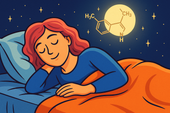
Melatonin and Menopause: Restoring Your Sleep Cycle
Nutrients are the foundation of hormone balance and energy. Learn how vitamins, minerals, and whole foods like greens, salmon, and berries nourish women’s bodies during menopause and beyond — restoring vitality, mood, and strength. 🌿🥗
-
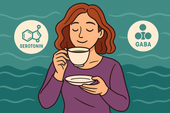
How L-Theanine Helps With Menopausal Anxiety
Science continually deepens our understanding of the human body, from hormones to neurotransmitters. Discover how evidence-based research shapes modern wellness — bridging natural medicine, neuroscience, and hormone balance for healthier living. 🔬🌿
-

Can Ginkgo Biloba Improve Memory in Menopausal Women?
Hormone therapy can be a powerful tool for easing menopause symptoms and restoring balance. Learn how it works, the types available, and how to combine it safely with lifestyle and natural support for optimal well-being. 🌸💊
-

B Vitamins for Mental Clarity During Menopause
Nutrients are the foundation of mental and physical balance during menopause. Discover how vitamins, minerals, and whole foods like leafy greens, fish, nuts, and citrus can fuel energy, clarity, and calm while supporting hormonal health. 🌿✨
-
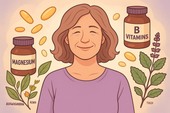
Mood Swings and Menopause: Natural Nutrient Support
Probiotics do more than support digestion — they help balance mood, hormones, and immunity too. Learn how a healthy gut microbiome can ease menopause symptoms, boost energy, and improve emotional resilience naturally. 🌿🦠
-

Brain Fog in Menopause: Supplements That May Help
Supplements can be powerful allies in restoring balance, energy, and focus—especially during menopause. Learn how nutrients like omega-3s, vitamin D, magnesium, and herbal adaptogens work together to support brain health, reduce stress, and promote lasting vitality. 🌿💊
-
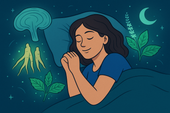
Adaptogen Stacks for Reducing Night Sweats
Hormone detox isn’t about cleansing your body—it’s about restoring flow. Learn how the liver, gut, and endocrine systems work together to eliminate hormone buildup and how herbs like milk thistle, dandelion, and schisandra support balance, clarity, and natural vitality. 🌿💫
-
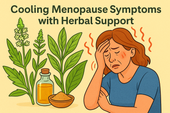
Cooling Menopause Symptoms with Herbal Support
Ashwagandha is one of nature’s most powerful adaptogens, helping women manage stress, sleep better, and balance hormones naturally. Discover how this ancient root supports calm energy, emotional resilience, and relief from menopause-related anxiety and fatigue. 🌿💫
-
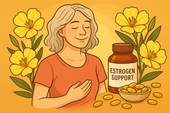
Evening Primrose Oil and Menopause: What the Research Says
Hot flashes are one of the most common—and frustrating—symptoms of menopause. Discover what causes them, why the body’s “internal thermostat” becomes unbalanced, and the natural supplements and lifestyle shifts that can help you cool down, rest better, and feel more in control. 🔥💧
-

How Black Cohosh Helps with Menopausal Symptoms
Sleep disturbances are among the most exhausting symptoms of menopause—but they don’t have to rule your nights. Discover how natural strategies and calming supplements can help you fall asleep faster, stay asleep longer, and wake up feeling truly restored. 🌙💤
-

Omega-3s and Menopause: Supporting Mood and Inflammation
Omega-3 fatty acids are essential for hormonal harmony, brain function, and emotional balance—especially during menopause. Learn how these healthy fats reduce inflammation, support heart health, and restore calm, vitality, and focus through every stage of midlife. 🌊💫
-
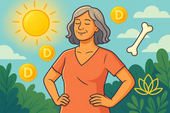
The Role of Vitamin D in Menopausal Health
Vitamin D plays a powerful role in menopausal health—supporting bone strength, hormone balance, and mood stability. Discover how optimizing your vitamin D levels can improve sleep, energy, and emotional well-being while protecting long-term vitality through every stage of menopause. 🌞💪
-
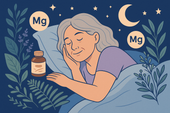
Magnesium for Menopause: Relaxation, Sleep, and Hormonal Support
Self-regulation is the art of staying calm, centered, and in control—no matter what life throws your way. Learn how to strengthen emotional balance, manage stress responses, and cultivate inner peace through mindful techniques that reconnect your heart, body, and brain. 🌿💫
-
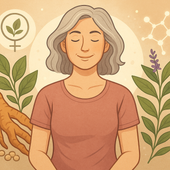
Can Adaptogens Like Ashwagandha Ease Menopausal Symptoms?
Brain fog during menopause can make even simple tasks feel overwhelming—but you’re not losing your sharpness, your hormones are simply shifting. Discover how adaptogens like ashwagandha and key nutrients can restore mental clarity, balance cortisol, and bring calm focus back to your day. 🌿🧠
-
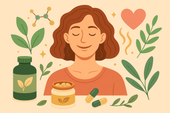
Supplements That Support Hormonal Balance During Menopause
Herbal supplements have supported women’s health for centuries—and modern science is finally catching up. From ashwagandha and maca to red clover and rhodiola, discover how nature’s most trusted herbs can calm stress, balance hormones, and enhance energy through every life stage. 🌿✨
-
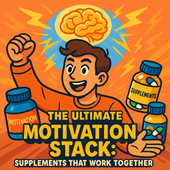
The Ultimate Motivation Stack: Supplements That Work Together
Discover how therapy helps restore motivation, focus, and emotional balance alongside supplement and mindset strategies. This empowering article explores how addressing thought patterns and emotional blocks through therapy can complement biochemical tools for long-term drive and well-being. 🧠💬
-

Entrepreneurial Drive: Can Supplements Help You Avoid Burnout?
Entrepreneurship demands energy, creativity, and mental resilience—but without balance, it leads to burnout. This in-depth article explores how nootropic supplements, adaptogens, and mindset tools can help entrepreneurs sustain motivation, manage stress, and keep their drive sharp for the long haul. 🚀💼
-

Supplements for Students: Staying Motivated Through Exams
Feeling burned out before finals? Discover how the right supplements can help students stay focused, calm, and motivated through exam season. This guide explores science-backed nutrients, brain-boosting herbs, and mindset tools that fuel clarity, memory, and stress resilience when it matters most. 🎓⚡
-
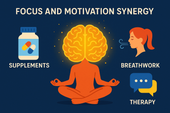
How Nootropic Stacks Can Enhance Drive and Focus Together
Discover how nootropic stacks can reignite both your drive and focus by balancing key neurotransmitters like dopamine and acetylcholine. This in-depth guide explores the science behind motivation, how supplements enhance cognitive performance, and how breathwork and therapy complete the picture for lasting mental clarity. 🧠✨
-
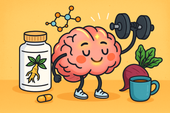
Natural Pre-Workout Supplements for Motivation and Mental Sharpness
Adaptogens are nature’s stress balancers 🌿 — powerful herbs like Ashwagandha, Rhodiola, and Holy Basil that help your body stay calm, focused, and resilient. By regulating cortisol and supporting energy balance, they boost motivation, endurance, and emotional stability — naturally. 🌞🧠
-
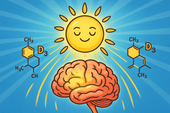
The Role of Vitamin D in Mental Drive and Ambition
Motivation is more than mindset — it’s energy in motion ⚡🧠. It comes from a balance of biology, emotion, and purpose. When your brain, body, and habits align, drive becomes effortless. Learn how to spark consistency, overcome dips, and build unstoppable momentum naturally. 🌿✨
-
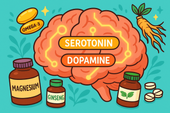
Serotonin, Dopamine, and Motivation: Can Supplements Really Help?
Ginseng is the ultimate vitality root 🌿⚡ — long praised for enhancing focus, energy, and motivation without the crash. By balancing stress hormones, boosting dopamine, and improving brain oxygenation, this adaptogenic powerhouse helps you feel clear, strong, and ready to take action. 🧠✨
-

How Ginseng Helps Support Drive, Motivation, and Energy
Ginseng is nature’s endurance root 🌿⚡ — a timeless adaptogen that fuels focus, drive, and resilience from the inside out. By balancing cortisol, boosting dopamine, and supporting mitochondrial energy, ginseng helps you feel clear, strong, and steady — no crash, just sustainable vitality. 🧠✨
-
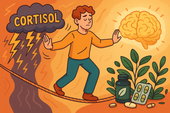
The Stress–Motivation Connection: Supplements That Balance Cortisol
Vitamin D — the “sunshine nutrient” ☀️ — plays a crucial role in mental health, motivation, and energy regulation. Low levels can lead to fatigue, low mood, and sluggish focus. Learn how sunlight, nutrition, and supplementation can restore your inner light and boost emotional balance naturally. 🌿🧠
-
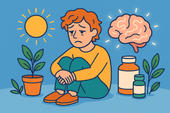
When Low Mood Drains Your Drive: Natural Support Options
Vitamin D is more than the “sunshine vitamin” ☀️ — it’s a key player in mood, motivation, and overall brain health. Low levels can lead to fatigue, low drive, and seasonal sadness. Learn how sunlight, supplements, and nutrition can help restore balance and lift your emotional energy naturally. 🌿🧠
-

How Adaptogenic Herbs Help You Stay Consistent
Adaptogens are nature’s resilience enhancers 🌿. From Ashwagandha to Rhodiola and Holy Basil, these herbs help your body adapt to stress, balance cortisol, and maintain steady energy. Learn how they build inner stability — keeping your focus, mood, and motivation consistent through life’s ups and downs. ⚡🧘
-

Can Creatine Boost Mental Drive as Well as Physical Performance?
IQ, or intelligence quotient, measures more than problem-solving — it reflects how efficiently your brain processes, adapts, and connects ideas 🧠⚡. While genetics play a role, lifestyle, nutrition, and brain health all influence cognitive performance. Learn how to support mental sharpness and cognitive growth naturally. 🌿✨
-
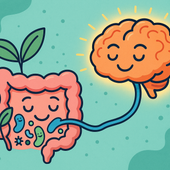
The Link Between Gut Health and Motivation: Probiotics Explained
Serotonin — the “feel-good” neurotransmitter 🌞 — plays a powerful role in mood, motivation, and overall emotional balance. Produced mostly in the gut, it connects digestion, happiness, and focus through the gut-brain axis. Learn how to naturally support serotonin for calmer energy and lasting motivation. 🌿✨
-
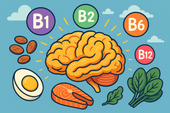
How B Vitamins Fuel Motivation and Energy at the Cellular Level
B vitamins are the body’s natural energy engines ⚡. They convert food into fuel, support dopamine for motivation, and power brain cells at the mitochondrial level. From B1 to B12, these nutrients help you stay focused, resilient, and full of drive — every single day. 🌿🧠
-
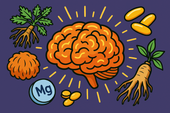
Supplements That Support Mental Endurance for Long Projects
Mindset is more than motivation — it’s the mental framework that shapes how you respond to challenges and pursue goals 🌿🧠. A growth mindset turns obstacles into opportunities, while a fixed mindset fuels self-doubt. Learn the science behind mental resilience and how to cultivate a mindset that sustains focus, creativity, and long-term success. ✨
-
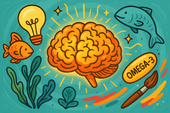
How Omega-3s Influence Drive, Creativity, and Problem-Solving
Sleep isn’t just rest — it’s the foundation of mental clarity, emotional balance, and motivation 🌙💤. During deep sleep, your brain resets stress hormones, consolidates memory, and clears away mental fog. Learn how better sleep supports neuroplasticity, creativity, and lasting energy for your day. 🌿✨
-
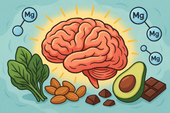
Can Magnesium Improve Your Focus and Motivation?
Caffeine is the world’s favorite stimulant ☕ — boosting alertness, sharpening focus, and lifting motivation within minutes. But there’s real science behind that morning cup. Learn how caffeine works on adenosine and dopamine, how to avoid the crash, and how to use it strategically for sustained energy and mental performance. ⚡🧠
-
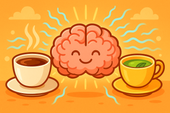
The Role of L-Theanine and Caffeine in Daily Motivation
Cortisol — often called the “stress hormone” — is both your alarm system and your reset button ⚡. It keeps you alert in the morning and helps you recover after challenges, but when it stays high too long, it drains your mood and energy. Learn how to balance cortisol naturally for steady focus, calm, and motivation. 🌿
-
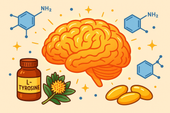
Supplements That Support Dopamine for Drive and Reward
Curcumin — the golden compound in turmeric — is more than a spice 🌿✨. It’s a powerful anti-inflammatory that protects dopamine neurons, supports brain clarity, and enhances mood. Learn how curcumin’s antioxidant properties help stabilize energy, reduce brain fog, and promote emotional resilience naturally. 🌼
-
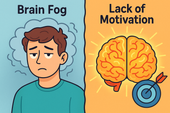
Brain Fog vs Lack of Motivation: What’s Really Holding You Back?
Hormones are the body’s invisible messengers — shaping energy, mood, focus, and motivation 🧠🌿. When they’re balanced, you feel clear, confident, and emotionally steady. Learn how key hormones like cortisol, serotonin, dopamine, and estrogen interact to influence your mental well-being and what you can do to keep them in harmony naturally. ✨
-

Supplements for Staying Collected During Disagreements
Science helps us understand why we feel, react, and change 🌿🧠. From brain chemistry to neurotransmitters and hormones, every emotional response has a biological root. Explore how research in neuroscience and psychology reveals practical ways to stay balanced, focused, and emotionally strong in daily life. 🔬✨
-

Managing Anger While Traveling
Supplements can help calm your nervous system and keep your emotions balanced while on the go 🌿. From magnesium and ashwagandha to L-theanine and omega-3s, learn how natural nutrients support stress resilience, focus, and emotional control — even through long flights, delays, and unpredictable travel days. ✈️
-

How to Keep Your Temper in Online Debates
Supplements can do more than fill nutritional gaps — they can help balance your energy, focus, and stress response naturally 🌿. From adaptogens to amino acids, the right nutrients support your brain chemistry and hormonal harmony for calm, steady productivity. Discover how supplements can build long-term resilience without the crash. ⚡🧠
-

Supplements to Stay Calm Before Public Speaking
Breathwork is one of the simplest yet most powerful tools for calming pre-performance stress 🌬️. By slowing and deepening your breathing, you lower cortisol, steady your heartbeat, and re-center your mind. Learn the science behind how controlled breathing activates your parasympathetic nervous system — helping you speak, perform, or focus with grounded confidence. 🌿
-

How to Handle Customer Service Stress Without Losing Your Cool 💬🧘♀️
Customer service can test even the calmest person’s patience. 😤 Learn how to handle difficult clients and daily pressure without losing your cool — through better mindset management, calming breathwork, and practical communication tools. Stay grounded, protect your energy, and transform stress into strength. 🌿
-
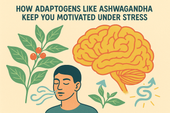
How Adaptogens Like Ashwagandha Keep You Motivated Under Stress
Feeling overwhelmed and unmotivated? 🌿 Discover how adaptogens like Ashwagandha can help you stay centered, focused, and energized under stress. Learn how supplements, breathwork, and therapy work together to restore your natural motivation and help you thrive — even during life’s toughest moments. 💪✨
-
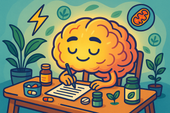
Supplements That Support Long-Term Productivity Without the Crash ⚡🌿
Cortisol — your body’s main stress hormone — can be both your best friend and worst enemy. ⚡ When balanced, it keeps you focused, energized, and ready to act. But when it stays high for too long, it leads to fatigue, anxiety, and emotional crashes. Learn how to regulate cortisol naturally through supplements, sleep, and stress management to maintain calm, steady productivity. 🌿
-
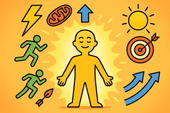
Why Energy Levels and Motivation Go Hand in Hand ⚡🧠
B-vitamins are the brain’s spark plugs 🔋. They turn food into fuel, support neurotransmitter production, and keep your mood, energy, and focus balanced. Learn how vitamins like B6, B9, and B12 work together to power the nervous system, reduce fatigue, and keep motivation high. 🌿
-
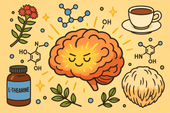
The Science of Motivation: Can Nootropics Help You Stay Focused? 🧠⚡
Nootropics are nature’s tools for sharper thinking and sustainable focus 🧠🌿. From Rhodiola and Lion’s Mane to L-theanine and Bacopa, these brain-boosting compounds enhance motivation, memory, and stress resilience. Learn the science behind how nootropics work — and how to use them safely for peak mental performance and clarity. ⚡
-
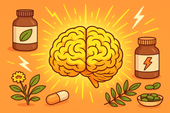
How Natural Supplements Can Boost Your Daily Drive
Cortisol is your body’s main stress hormone — powerful, necessary, but often misunderstood. ⚡ When balanced, it keeps you alert and energized; when chronically elevated, it drains mood, motivation, and focus. Learn how to regulate cortisol naturally through nutrition, supplements, and calming lifestyle habits for steady energy and emotional balance. 🌿
-
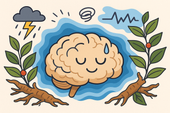
Ashwagandha for Stress and Low Mood
Breathwork is more than a relaxation tool — it’s a way to rewire your nervous system. 🌬️ Through intentional breathing, you can reduce stress hormones, improve focus, and calm emotional turbulence. This guide explores the science of breathwork and its powerful effects on mental clarity, resilience, and emotional regulation. 🌿
-
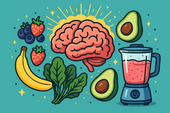
Mood-Boosting Smoothie Recipes
Your blood sugar affects far more than energy — it influences mood, focus, and emotional stability too 🍎. Learn how maintaining balanced glucose levels supports brain health, reduces anxiety, and prevents emotional crashes. Discover the foods and habits that keep your mind calm and your energy steady throughout the day. 🌿
-
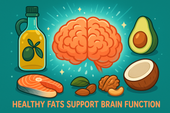
How Healthy Fats Support Brain Function
Your brain thrives on healthy fats 🧠💧. From omega-3s to MCTs, the right fats enhance focus, memory, and mood while protecting against inflammation and aging. This article explores how good fats — like those from olive oil, salmon, avocado, and nuts — build sharper thinking, emotional balance, and lasting brain vitality. 🌿
-
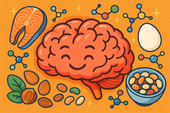
The Role of Protein in Mental Clarity
Protein isn’t just for muscles — it’s for your mind. 🧠 This guide explores how amino acids from high-quality protein fuel neurotransmitters, stabilize mood, and sharpen focus. Learn how balanced protein intake supports dopamine, serotonin, and energy regulation to boost mental clarity and emotional stability naturally. 🍳🌿

















































